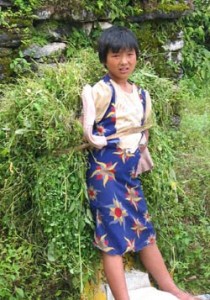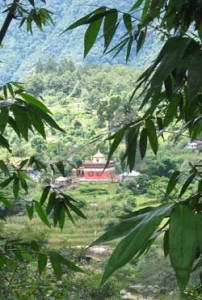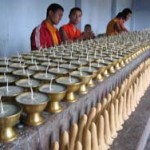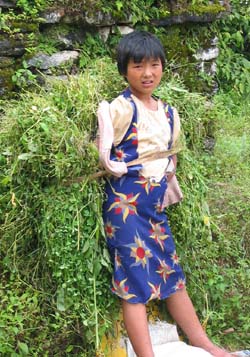
Sikkim’s original inhabitants, the Lepchas, call their land Nyemael , “Paradise.” Though one of the legendary “bayul” or Shangri-la valleys that refer to a handful of remote valleys of the Himalayas was said to be only behind the mighty Kanchenjunga, rather than implying the entire former Kingdom, Sikkim, now the 22nd state of India, has very much the same characteristics as the other fairy tale kingdoms of the Himalayas.

The Buddhist patron-saint of Sikkim is Guru Rinpoche who is said to have passed through the land in the 9th century and introduced Buddhism to Sikkim. As a result landscape is studded with many picturesque monasteries, much like Bhutan further to the east. Though most monasteries extol Padma Sambhawa and follow the Nyingmapa order, or Red Hat school of Buddhism, since 1959 when the 16th Karmapa arrived in Sikkim after Tibet was overrun by the Chinese, Rumtek, a large monastery near Gangtok, has become the seat of the Tibetan Karma Kagyu lineage.

Same as its neighbors, Sikkim too was a monarchy, presumably since the 13th century though the first king, or Chogyal, of Sikkim was not consecrated until 1642 in Yuksom, in West Sikkim. The end of Sikkim’s monarchy came on April 6, 1975 when the Indian army subdued the palace guards, placed the king under house arrest and Sikkim ceased to exist as an independent kingdom, its sovereignty lost. It is said that Sikkim’s merger with India was necess
ary for India’s national security since India’s first cross border skirmishes with the Chinese in the 1960s. China claimed Sikkim to be part of Tibet, hence part of China and India feared vulnerable to an attack should Sikkim succumb to China. Though the eventual annexation of Sikkim to India was years in the making, perhaps as far as back as 1947 when India gained independence from the British, fact is also that India played dirty in the process, staging referendum vote whether the people wanted to become part of the union, all to pave the road to justification of the eventual annexation. Hailed as expression of democracy, those that remember the voting and events of those days well recall India hauling in masses of poor folks from the plains, some said to have been brought from as far south as Bihar to vote, all to show the wish of the majority was to join the Indian Union. No foreign press was allowed into Sikkim for a long time and even as late as 1980s number of those that used to be close the former Chogyal and agitated against India’s rule lingered off and on in Indinan prisons.

Today, most Sikkimese know they lost their independence in 1975, and the plains-bound passengers from the hills still say they are “going to India” despite that indeed they are in India. The pride of the carries on and it is good to see that the young generation has not lost their identity, quite the contrary. Although India has always been hailed as the largest democracy and praised for its practices, it seems the spirit of democracy it sowed in Sikkim is a far cry from its otherwise fine track record.

I am disappointed that you said China claim Sikkim to be part of China. China never claim Sikkim to be part of China and respect Sikkim as an independent kingdom. China does claim Tibet to be part of China. You can do some research into this area to see how strong or weak China’s claim is.
In regards to the 1962 war between India and China, please listen to this podcast:
http://asiapacific.anu.edu.au/podcasts/India_China_Border.mp3
and read up on this link:
http://www.gregoryclark.net/redif.html
If India didn’t invade and annex Sikkim, Sikkim will still be an independent kingdom today.